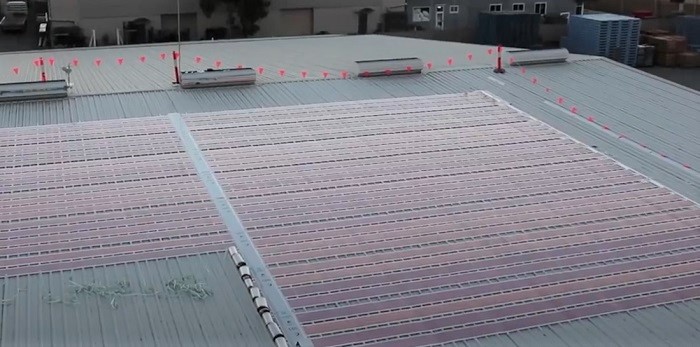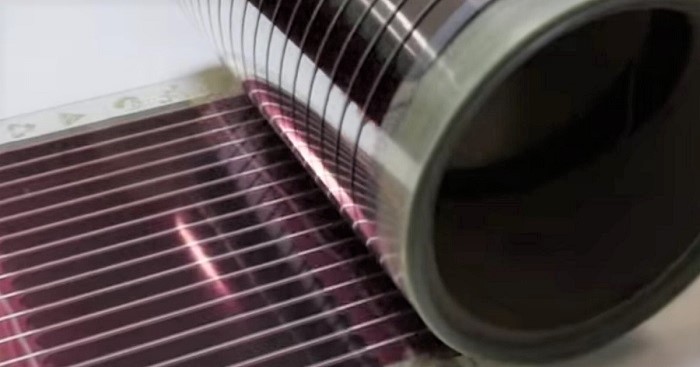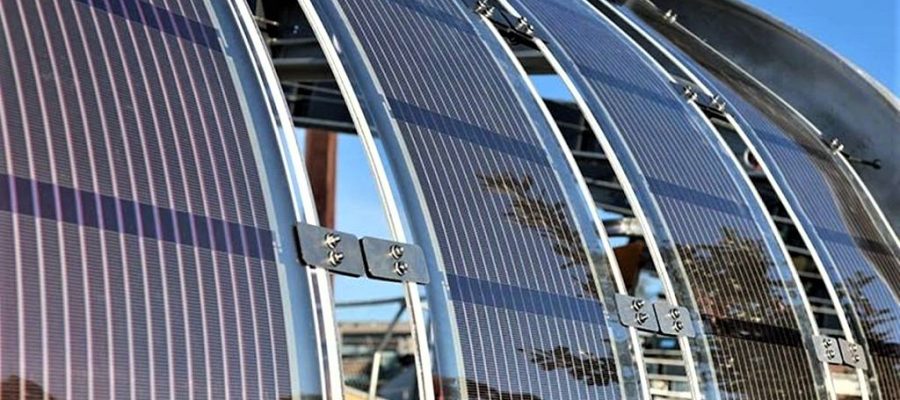Iluzie sau revolutie in domeniul energiei regenerabile?
O echipa de cercetatori de la Universitatea din Newcastle (Australia) condusa de Prof. fizician Paul Dastoor, a tinut prima pagina a ziarelor la finele anului 2018, cand au montat o suprafata de 200 de metri patrati de panouri solare functionale pe acoperisul unei fabrici din oras (cladirea CHEP).
Sustinatorii noi tehnologii spun ca aceasta pot revolutiona modul in care panourile solare sunt fabricate si distribuite in intreaga lume.
Insa, dincolo de toata popularitatea din media, trebuie sa precizam ca panourile printate sunt mai putin eficiente decat panourile din silicon, ele avand o durabilitate de numai doi ani, iar procesul lor de productie nu este atat de simplu pe cat ar parea.

Asadar, merita sau nu panourile printate toata aceasta expunere de care se bucura in media? Ar putea ele sa transforme energia regenerabila intr-o optiune accesibila?
Cum este printat un panou solar?
Celulele solare sunt realizate dintr-un material semi-conductor care poate fi incarcat pozitiv sau negativ pentru a avea mai multi sau mai putini electroni si astfel sa capete o conductivitate pozitiva sau negativa.
Cei mai multi semi-conductori, asa cum este si siliconul, sunt friabili (se faramiteaza, se sparge usor), asa ca echipa de la Newcastle, condusa de Paul Dastoor a creat cerneluri din polimeri flexibili semi-conductori.
Primul strat de cerneala semi-conductoare este printat pe o foaie transparenta din plastic, dupa care alte straturi sunt printate unul peste celalalt, pana cand polimerii ating o grosime de aproximativ 200 de microni. Ca referinta, un fir de par uman are o grosime de aproximativ 50 de microni.
„Apoi producem un strat superior de contact, care este facut din nou cu ajutorul unei tehnologii cunoscute ca sputter coating”, spune profesorul Dastoor.
Panourile pentru cladirea CHEP au fost printate pe role de 10 metri, in final 640 de metri de panouri solare fiind desfasurate si conectate in serie pentru a acoperi o arie de 200 de metri patrati de panouri.
Pe ce suport se pot printa panourile solare?
Suportul fizic pe care sunt imprimati polimerii sensibili este plasticul, asa ca ar trebui sa fie durabil, astfel, acest tip de panou solar poate fi imprimat direct pe zid, pe fereastra sau pe orice alt material.
Este mai bun un panou solar printat decat unul obisnuit?
Din perspectiva noastra raspunsul este NU. Panourile printate sunt mai putin eficiente in acest moment, iar potrivit profesorului Dastoor ele au o durabilitate de numai doi-trei ani. Insa promotorii lor sustin ca ele ar fi mai avantajoase din punct de vedere al costurilor, al usurintei productiei, precum si din punct de vedere al greutatii.
Cat costa productia de panouri solare printate?
Suprafata de 200 de metri patrati din Newcastle Australia a fost acoperita cu panouri in decursul unei singure dupa-amieze, panourile fiind fixate pe acoperis folosind banda dublu adeziva. Costul unei fabrici de productie de semiconductori, unde este rafinat siliconul pentru panouri, ajunge pana la miliarde de dolari; costul dotarilor pentru printarea de panouri solare este de ordinul miilor.
Ca o comparatie, costul combinat al imprimantelor celor de la CSIRO (Commonwealth Scientific and Industrial Research), folosite pentru panourile solare printate s-a ridicat la mai putin de 500.000 de dolari.
Echipa din Newscatle estimeaza costul modulelor sale la mai putin de 10 dolari per metru patrat. La acest pret, 200 de metri patrati de panouri ar costa sub 2000 de dolari.

In prezent, panourile solare au o eficienta de o cincime din eficienta panourilor din silicon. Daca eficienta lor ar putea fi dublata, echipa estimeaza ca o suprafata de 150 de metri patrati ar putea acoperi necesitatile energetice ale unei gospodarii medii.
Se pot recicleaza panourile solare printate?
Panourile solare printate se bazeaza foarte mult pe plastic si, data fiind durata lor redusa de viata, ele au potentialul de a adauga o cantitate mare de plastic fluxului nostru obisnuit de deseuri. O parte a proiectului Universitatii Newscastle din Australia va incerca sa recicleze plasticul la finalul instalarii.
“Acest trial presupune instalarea panourilor pentru o perioada de sase luni; le instalam, le testam performanta, iar la final le dam jos si le reciclam” a spus profesorul Dastoor.
In mod ideal, ele vor fi reciclate astfel incat sa devina din nou panouri, dar este un proces netestat deocamdata.
Bibliografie:
https://www.newcastle.edu.au/
https://zinnaida.ro/
https://dan-marius.ro/
https://www.solarquotes.com.au/


O direcție nouă și interesantă de cercetare-dezvoltare care s-ar putea să aibă perspective randament/profit mare în viitor..
Aici, cel mai mare avantaj l-am vazut ca fiind flexibilitatea montarii (ondulare) dar si printarea pe diverse suprafete.
Avea bunica o vorbă: mămăligă din râșniță și pește din undiță! Celor care nu știu ce înseamnă, le pot explica.
Râșnița era o mini-moară rudimentară la care învârteai până te apuca noaptea ca să faci un pumn de mălai, așadar, nu te poti vedea sătul cu astea două, undița și râșnița.
Să crezi că dacă pui panouri solare te vezi cu lumină si căldură suficiente, inseamnă să depinzi de zilele cu soare.
Da, imi veti zice de baterii, convertizor, chestii, dar ce te faci dacă prinzi trei săptămâmi de iarnă fără soare?
Astea sunt mofturi de haștagi globalisti, nădejdea e tot la generatoarele clasice, pe combuatibili, pe tehnologie nucleară, pe hidrotehnologie etc.
Hai să fim seriosi, dacă nu bate vântul trei zile te.. pe ea de eoliană!
Bateriile se descarcă si faci focul cu lemne, ca să ai si căldură si lumină!
Până când nu se vor descoperi materiale care să reziste la temperaturile generate de FUZIUNE mai stăm pe ce avem.
Nu sunt nici pro nici contra la ceea ce ati spus. Dar totusi daca folosim sursele alternative inteligent, poate nu am consuma atat de multe resurse.
Eu stau la tara si ma incalzesc cu lemne si da daca as avea un buget generos as investi in panouri fotovoltaice si eoliana si in timp garantat consumul de lemne scade.
Uitasem, lemne nu am cumparat si nu o sa cumpar in viata mea, nici copii nici nepotii. Pe fiecare an plantez, cumpar teren plantez si tot asa..
Interesanta abordare. Imi place ca aveti o mentalitate dedicata dezvoltarii continue.
Orice masa plastica printata este din punct de vedere mecanic de proasta calitate comparativ cu materialul turnat/presat normal si firesc.
Honestly, the efficiency of the solar cell has to increase more than 25% over how many years since the invention of the solar cell? What exactly is the specifications on these printed panels? Are they greater than 25% efficiency? The spectrum of light that gives us the most efficiency is I believe in the green spectrum of light?
Well, not only that, I often see people complaining about the efficiency when even comparing it to other fuel sources… All the efficiency means, is how much of the solar radiation hitting the ground at that specific moment, is converted directly into electricity -with 100% being the absolute maximum, everything utilized.
You have people comparing this value then to other systems… It’s not even apples and oranges. How much solar radiation does it take to convert a tree into organic matter, to grow enough mass, to be converted by its own weight into, oil? Or even, how efficient is a plant, converting solar into creating biomass, to create biodiesel. They’re not even comparing that conversion. Let’s say something like, it’s cloudy so you’re only getting like 11% efficiency. Yeah? Compared to what?
Then you have to consider factors like if you just compare one gallon of gasoline, and how efficient you are and extracting that energy, even that doesn’t apply – because once you burn that gallon of gas, you no longer have that gallon of gas, but you still have that solar panel working at whatever efficiency rating that will continue doing so for its lifetime… It’s not done after producing x watthours in 1 hour. (Yet another rating)
For my instance, I’m talking the efficiency over the evolution of the solar cell itself. While you’re talking of the efficiency over different ways to generate electrical power I presume? If we’re talking about absolutes then I generally have to be accurate in my data otherwise I could very well have errors in my data. Since you’re talking about how much solar radiation it takes to convert a tree into organic matter, to grow enough Mass, to be converted by its own weight into, oil? Please elaborate all those different pieces of information into an answer if you are knowledgeable about solar radiation to convert a tree into organic matter?
A total of 173,000 terawatts (trillions of watts) of solar energy strikes the Earth continuously. That’s more than 10,000 times the world’s total energy use. And that energy is completely renewable — at least, for the lifetime of the sun.
When absorption and scattering are taken into account, the total solar flux reaching the surface of the earth is estimated to be 1.08×108 GW and the total amount of energy reaching the surface of the earth each year is 3,400,000 EJ. This is between 7000 and 8000 times annual global primary energy consumption. I see your information regarding to once you burn a gallon of gas, you no longer have the gallon of gas, but you still have solar panel working at whatever proficiency rating that will continue during so for its lifetime. We have to take inconsideration when we’re burning a gallon of gas the the fuel is converted over eventually hits the tailpipe as a mist, water vapor, and all other byproducts of burning that fossil fuel, so there’s a lot of missing data in between the time we put that gallon of gas in the tank to what’s left over after the gas is went through the engine it’s efficiency is not exactly known to me, but I know after it leave the tailpipe there’s water that leaves the tailpipe, smoke, and other chemical compounds.
Let’s stick, and focus upon the solar
The PSCs gave the stable power output of 12.2% – the highest efficiency recorded for four layers of roll-to-roll printed PSCs to date. https://techxplore.com/news/2020-07-efficiency-solar-cells.html
So, a whopping 122 watts per square meter of active surface – but only with a clear sky and the sun directly overhead.
This would take about 1.6 hours to charge an electric car so it could go one mile – under ideal conditions. It goes down from there.
They are approaching the arena of usefulness now, but will probably never replace rooftop or dedicated silicon solar. They are likely to find application on more protected portions of a building such as exterior walls and eves. A silicon crystal solar panel, in some sense, lasts forever. It will continue to produce power, though at a slightly efficient rate for 40-50, maybe 100 years? There are several examples of solar cells producing 50+% of their rated power 40 years out from installation the world over and these are likely to become more common.